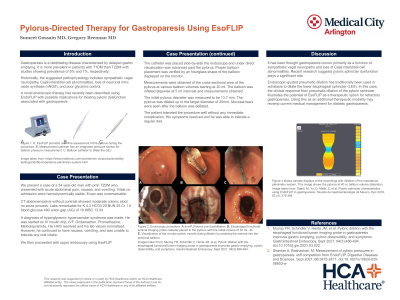Back


Poster Session A - Sunday Afternoon
Category: Stomach
A0735 - Pylorus-Directed Therapy for Gastroparesis Using EsoFLIP
Sunday, October 23, 2022
5:00 PM – 7:00 PM ET
Location: Crown Ballroom

Has Audio

Sumeet K. Gossain, MD
Medical City Arlington
Arlington, TX
Presenting Author(s)
Award: Presidential Poster Award
Sumeet Gossain, MD1, Paul Aguilera, MD1, Gregory Brennan, MD2
1Medical City Arlington, Arlington, TX; 2GI Alliance, UNT Health Science Center, Mansfield, TX
Introduction: Gastroparesis is a complex disease with limited pharmacologic treatment options. Pyloric dysfunction is increasingly recognized as playing an important role in the pathophysiology of the disease which has led to increasing interest in pylorus-directed therapy. The novel endoscopic functional lumen imaging probe (EndoFLIP) and the EsoFLIP catheter allows for dynamic measurement and directed intervention.
Case Description/Methods: A 34-year-old man with a past medical history of diabetes mellitus and gastroparesis was admitted after presenting with significant epigastric pain, nausea and vomiting. His initial glucose was 451 mg/dL. The patient was initially treated with an insulin drip, intravenous fluids, and antiemetics including alternating ondansetron, promethazine, and metoclopramide. Despite improvement in the patient's hyperglycemia, the symptoms of nausea and vomiting persisted. The patient underwent esophagogastroduodenoscopy (EGD) with therapeutic intent. The initial endoscopic exam ruled out any mucosal lesions or mechanical obstruction. The EsoFLIP catheter was placed side-by-side the endoscope and under direct visualization was advanced past the pylorus. Proper balloon placement was verified by an hourglass shape of the balloon displayed on the monitor. Measurements were obtained of the cross-sectional area of the pylorus at various balloon volumes starting at 30 ml. The balloon is inflated stepwise at 5 ml intervals and measurements were obtained. The initial pylorus diameter was measured to be 13.7 mm. Care was taken to directly visualize the mucosa during the procedure. The pylorus was dilated up to a diameter of 25mm. Mucosal rents (tears) were seen after the balloon was deflated. The patient tolerated the procedure well without any immediate complication. His symptoms resolved and he was able to tolerate a regular diet.
Discussion: Endoscopic functional lumen imaging probe uses impedance planimetry to calculate pyloric distensibility. Therapeutic dilation using the EsoFLIP system allows real-time and dynamic visualization of the pyloric sphincter with measurements of diameter, cross-sectional area and intra-balloon pressure. This case highlights the therapeutic protentional of EsoFLIP pylorus dilation for refractory gastroparesis. Here we follow a previously described step wise protocol for using the EsoFLIP with the goal of achieving a target pylorus diameter of 25 mm. This protocol has been shown to lead to improvements in symptoms and FLIP metrics as demonstrated in our case.
Disclosures:
Sumeet Gossain, MD1, Paul Aguilera, MD1, Gregory Brennan, MD2. A0735 - Pylorus-Directed Therapy for Gastroparesis Using EsoFLIP, ACG 2022 Annual Scientific Meeting Abstracts. Charlotte, NC: American College of Gastroenterology.
Sumeet Gossain, MD1, Paul Aguilera, MD1, Gregory Brennan, MD2
1Medical City Arlington, Arlington, TX; 2GI Alliance, UNT Health Science Center, Mansfield, TX
Introduction: Gastroparesis is a complex disease with limited pharmacologic treatment options. Pyloric dysfunction is increasingly recognized as playing an important role in the pathophysiology of the disease which has led to increasing interest in pylorus-directed therapy. The novel endoscopic functional lumen imaging probe (EndoFLIP) and the EsoFLIP catheter allows for dynamic measurement and directed intervention.
Case Description/Methods: A 34-year-old man with a past medical history of diabetes mellitus and gastroparesis was admitted after presenting with significant epigastric pain, nausea and vomiting. His initial glucose was 451 mg/dL. The patient was initially treated with an insulin drip, intravenous fluids, and antiemetics including alternating ondansetron, promethazine, and metoclopramide. Despite improvement in the patient's hyperglycemia, the symptoms of nausea and vomiting persisted. The patient underwent esophagogastroduodenoscopy (EGD) with therapeutic intent. The initial endoscopic exam ruled out any mucosal lesions or mechanical obstruction. The EsoFLIP catheter was placed side-by-side the endoscope and under direct visualization was advanced past the pylorus. Proper balloon placement was verified by an hourglass shape of the balloon displayed on the monitor. Measurements were obtained of the cross-sectional area of the pylorus at various balloon volumes starting at 30 ml. The balloon is inflated stepwise at 5 ml intervals and measurements were obtained. The initial pylorus diameter was measured to be 13.7 mm. Care was taken to directly visualize the mucosa during the procedure. The pylorus was dilated up to a diameter of 25mm. Mucosal rents (tears) were seen after the balloon was deflated. The patient tolerated the procedure well without any immediate complication. His symptoms resolved and he was able to tolerate a regular diet.
Discussion: Endoscopic functional lumen imaging probe uses impedance planimetry to calculate pyloric distensibility. Therapeutic dilation using the EsoFLIP system allows real-time and dynamic visualization of the pyloric sphincter with measurements of diameter, cross-sectional area and intra-balloon pressure. This case highlights the therapeutic protentional of EsoFLIP pylorus dilation for refractory gastroparesis. Here we follow a previously described step wise protocol for using the EsoFLIP with the goal of achieving a target pylorus diameter of 25 mm. This protocol has been shown to lead to improvements in symptoms and FLIP metrics as demonstrated in our case.
Disclosures:
Sumeet Gossain indicated no relevant financial relationships.
Paul Aguilera indicated no relevant financial relationships.
Gregory Brennan indicated no relevant financial relationships.
Sumeet Gossain, MD1, Paul Aguilera, MD1, Gregory Brennan, MD2. A0735 - Pylorus-Directed Therapy for Gastroparesis Using EsoFLIP, ACG 2022 Annual Scientific Meeting Abstracts. Charlotte, NC: American College of Gastroenterology.

